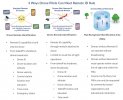- Joined
- Oct 28, 2017
- Messages
- 117
- Reaction score
- 98
- Age
- 65
The FAA are trying to set safety regulations on a hobby without even doing any RISK MANAGEMENT ASSESSMENT. How many manned aircraft have been downed by hobby multi rotors? How many deaths have occurred because of unmanned multi rotor aircraft? I have no problem with exclusion zones and obey them. What I don't like is government telling me how to spend my hobby dollars!!!!Rogue? Not. The FAA is responsible for developing regulatory and operational systems in response to laws passed by an elected and representative congress. That’s what they do. They are not rogue. That’s our system of constitutional democracy.
Complete failure? Not. Much of what drone operators may be experiencing as oppressive regulatory oversight is a result of air safety methods developed in response to terrible accidents with horrific loss of life for those in aircraft *and* on the ground.
One could certainly argue that FAA has either “erred on the side of caution” or “hugely overreached” in drone safety regulation. I personally can’t imagine wanting to travel by air if the FAA was more hands-off. They recently responded to anti-regulatory interests with a more self-regulatory system for airplane manufacturers, we all saw those results. No thanks.
My sense is that drone operation ballooned so quickly that it’s been difficult for any government to respond as quickly as we would like. Maybe the FAA should have gone faster, but that’s government, it doesn’t make them rogue or a complete failure. I’m happy to see new regs this year making it easier, cheaper, and more valuable for pt. 107 pilots to keep up their certificates, and great updates for easily accessible and safe methods for flying over people and night flying. FAA is not standing still.
Integration of drones in the National Airspace System via Remote ID is a tough nut any way you try to crack it. I think FAA made some major missteps in their early notices. To their credit, they’ve largely corrected them. I don’t know what my personal financial hit will be when it comes time to purchase RID modules, it’s hard to be happy about that, but I WILL DO IT.
Safety is important, too important to be left to individuals‘ interpretations of best practices, because there are plenty of yahoos out there who don’t seem to care about anything but themselves. I don’t want my family’s and community’s safety to be dependent only on others’ good will. The track record isn’t good. The FAA’s work in air safety is important. They can’t provide a guarantee, but do improve the odds.
Cell phones have killed more people than RC aircraft. Where is the government regulations about those tragedies?
These regulations have nothing to do about SAFETY. It's all about the money!!! They will ruin a 2 billion dollar hobby industry so they can open up airspace for the commercial drone market to rent airspace on a paying basis. Don't believe me? Google your local airports tax revenue. It will make you sick. The mismanagement and corruption is epic. Airport managers making six figures for a part time position.
Don't confuse SAFETY with POTENTIAL REVENUE. The government don't care about you. Only your wallet.



